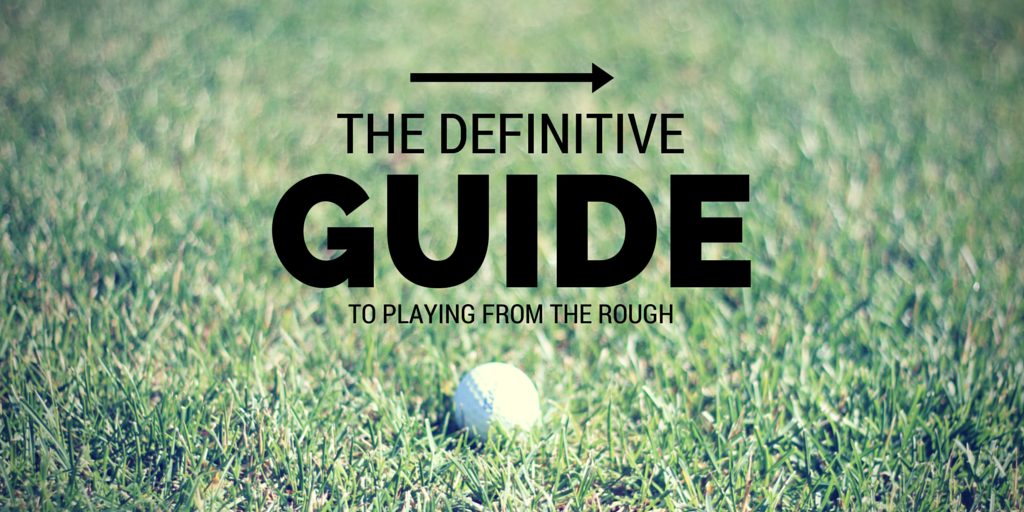
If your ball has found the rough with your tee shot, the next decision you make is extremely important. One of the biggest mistakes most golfers make is not evaluating their lie in the rough properly. If you are too aggressive, and do not anticipate how the club face will react to your lie, you will ultimately compound your initial mistake.
When your ball is in the rough you are in some form of trouble. Your main goal should be to play the highest-percentage shot based on your lie, and return your ball back to safety. Anything you can do to prevent striking the grass before the ball is important.
You're Not in the Fairway, Things are Different
If you've found the deeper stuff with your tee shot, your strategy should immediately shift. Don't assume that you will be playing the same club for the distance that you would if you were on the fairway. Overall, It is not going to be easy to land ball on the green for a couple of reasons.
- Depending on your lie, it will be more challenging to produce a consistent, clean strike that will get your ball moving towards your target.
- You won't be able to spin the ball, and it will likely release much farther than usual if you do hit the green.
Knowing this, when you approach your ball you should not be in an aggressive mindset. It still might be possible to hit the green based on your distance and lie, but above all you should be concerned with playing a shot that won't bring double or triple bogey into play.
Do not make your initial mistake even worse with another one. You will have a much greater margin of error out of the rough.
This is a form of course management, and I think it's one of the most important topics in golf. Check out my eBook on the topic here (I'm giving it away for free to members of my newsletter).
I'm going to talk about a few different lies, and give you some ideas on how you should play them.
The Buried Lie
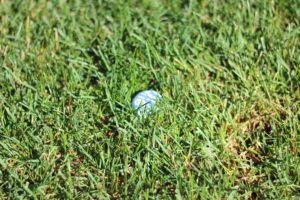

If your ball looks something like this, you can most likely forget about trying to get on the green. When half, or more of the ball is below the the rough you are going to have an extremely difficult time getting the club face on the ball. I believe these are the lies that can have the greatest impact on your round because if you make the wrong decision it could result in some very big numbers.
When you see the pros on TV hitting spectacular shots out of buried lies it's because they have tremendous swing speed, and control over the face of the club at impact. Do not think you are going to be able to do the same thing!
The main problem with these lies is the grass grabbing the club head at impact. The key to counteracting this is coming down on the ball on a steeper angle so you can "dig" it out.
When you use your longer irons, your club head will naturally come on a more shallow path, which is not good. The face of the club will have a tendency to grab in these instances because you are making contact with the grass before the ball. This will often cause your misses to go left because the club face be closed at impact.
So what's the key to getting out of this lie? Take your medicine, and use a much shorter club. If you're 170 yards from the green, and trying to go for broke with a long iron, I can assure you that your ball will go nowhere near where you are aimed most of the time.
Using a shorter club like a 9-iron or wedge will allow you to dig through the grass more easily because you'll be coming down on a steeper angle. Remember, we are trying to limit the amount of grass we strike before the ball.
Here are some adjustments you can make when trying to dig out of a buried lie:
- Play the ball further back in your stance, which will help you hit the ball first instead of the grass.
- Keep the club face a little more open so it will counteract the grass from shutting the club face to a closed position at impact.
- Don't try and kill the ball! Swinging harder will prevent you from making the clean strike that you need to get the ball out.
When you have a buried lie your options become very limited. I believe you should just try to get back to the fairway with a shorter club, give yourself a chance of making a par save, and make bogey at worst. If you go for the aggressive shot you are unlikely to pull it off, and now you have brought double and triple bogey into play.
The In-Between Lie
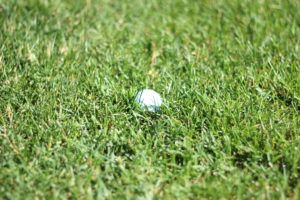
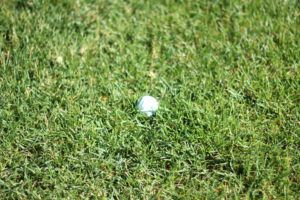
Let's say you walk up to your ball, and things aren't that bad. You can see a decent amount of the ball, and there isn't too much grass in the way.
You are still not completely out of the woods! One of the keys on these lies is to take a look at which direction the grass is growing (if there is a distinct pattern). Here are two scenarios for what I would call an "in betweener."
If the grass is growing against you: It's going to be a little bit harder to hit the ball cleanly. If you hit the grass before the ball, it will grab the club more, and cause most of the same issues that a buried lie would. I would be more conservative with these lies, especially if you are more than 150 yards away from the hole. Use many of the same techniques discussed in the buried lie section.
If the grass is growing with you: This is generally a better lie, and the grass won't offer as much resistance. These are the types of lies that can produce a "flier" where your ball will come out hotter than usual, and travel farther than you expect. In these instances I would actually take a little less club, and prepare for the ball to run out more when it lands.
These are the kinds of lies that can have completely different results based on how you hit the ball, and the conditions of the grass. You can catch them heavy, or get a flier that will travel farther than anticipated. If you can't distinguish any kind of pattern in the grass growth you should still plan on trying to dig the ball out with a shorter club. Be honest with the lie, and don't go for the hero shot.
The Fluffy Lie
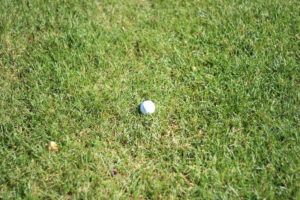

Depending on the type of grass at your course, and how they cut it, you might find yourself with the fluffy lie. This can be a little exciting. I find when I'm playing down in Florida in Bermuda grass this often happens.
Do not get fooled by the fluffy lie, it can be just as dangerous as the buried lie. The issue with these lies is that you will still hit some grass before the ball, which will reduce the amount of backspin. Your ball can go much farther, and will roll out more when it lands.
Since the lie is much cleaner, you can give the green a go if you are 150+ yards out. If you play with hybrids it will be much easier to hit the ball cleanly from these lies so they can be a great asset (everyone should be playing with hybrids!).
A couple of things to keep in mind on this lie:
- The ball is teed up a bit, and above your feet. Your tendency might be to hit underneath it. Try hovering the club even with the ball when you address it.
- Depending on how high the ball is above the grass, take 1-2 clubs less, and prepare for the ball to travel much farther than usual.
Closing Thoughts
Playing effectively out of the rough takes a lot of experience. You will naturally figure out how all kinds of lies will affect your ball flight over time. No matter what, it's still difficult to predict just how your ball will react. I believe your focus should be on limiting the damage, and playing the shot that will get you back to safety.
The main point I hope you come away with from this article is that not all lies are created equal. Many players step up to their ball and choose the same club they would from the fairway, which is a huge mistake.
You have to accept the fact that the rough is meant to be a penalty for not hitting the fairway. Our tendency is to be more aggressive because we might be trying to save the hole. As hard as it is, we have to resist the urge to pull off the low-percentage shot. We might not realize it when we're in the moment, but these are the situations that will ultimately dictate what kind of score we will shoot.
We care about the protection of your data Read our Privacy Policy